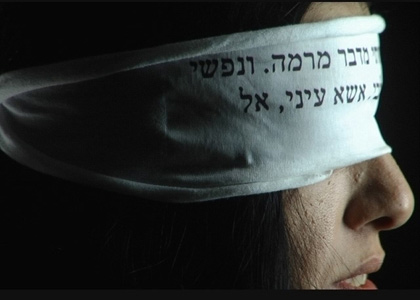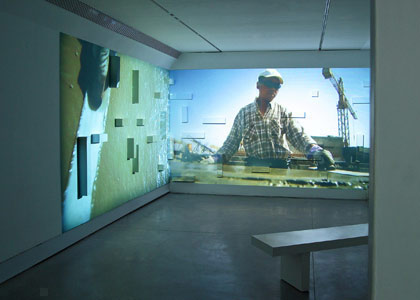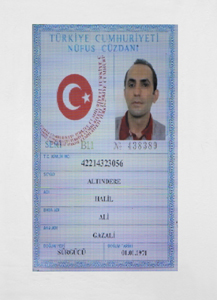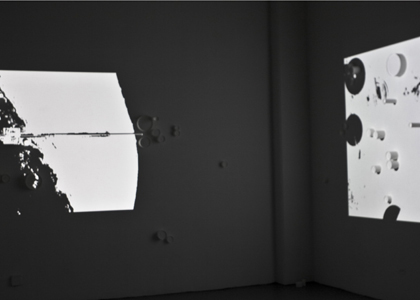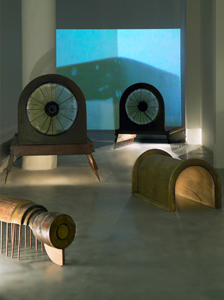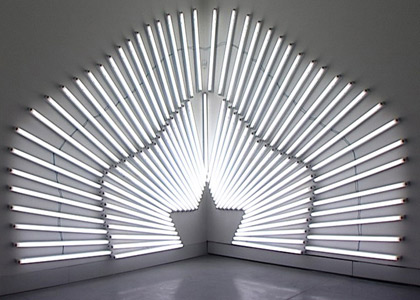Blind Spot
Curator: Carmella Jacoby Volk, Einat Manoff
05/06/2008 -
25/10/2008
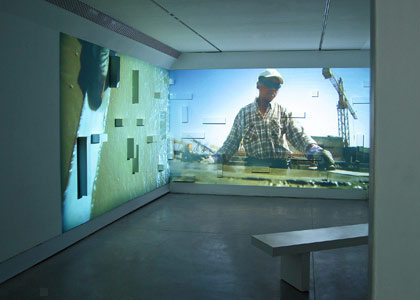
Participants: Assaf Evron, Ori Drumer, Duprass: (Liora Belford and Ido Govrin) with Oscar Abosh, Dafna Shalom, Halil Altindere, Jan Tichy, Yochai Matos, Maya Shan Bowden, Micha Ullman, Miri Segal, Manar Zuabi, Solmaz Shahbazi, Sasha Serber, Raed Bawayah, Shay Id Alony
How can you map the blind spot? Stand some 30—50 cm from the screen and cover your left eye; fix your gaze on the + sign at the left. Now draw slowly away from the screen. At a certain distance the sign will disappear.
“What do you see now?” “I see that I don’t see”
0 +
The present exhibition exposes blind spots and blocks in the collective gaze at the social, political and chronological expanses, as well as at the urban environment in the Middle East. The works presented here examine the impact that these spots yield on the local artistic field, on the individual’s perception of the collective (and vice versa) and on perceptions of the architectural-museum space.
A blind spot, also known as a scotoma, is an obscuration of the visual field. A particular blind spot is the place in the visual field that corresponds to the lack of light-detecting cells on the retina- where a part of the field of vision is not perceived. The brain fills in with surrounding detail and with information from the other eye, so the blind spot is not normally perceived. This blind spot influences our environmental perception and behavior. Aside from its optical and physiological definitions, the blind spot serves as a metaphor, applied in social, psychoanalytical and political contexts. In these contexts the blind spot connotes an observation of society and the environment, limited by cultural-social presumptions.
This exhibition employs the blind spot as a critical mechanism, which allows for a spatial experience. In one aspect the “blind spot” points to the limitations of the gaze and the importance of art in exposing those areas which escape the eye due to these spots; on the other hand the blind spot is interpreted as a suspension of visual perception as a ‘state of distraction’ – of physical experimentation in space. The blind spots in the exhibition are exposed in moments of “distraction”, flashes of time, light and motion in a dark space. When our consciousness is overloaded visually, moments of “void” are produced. These moments represent a threshold state between consciousness and its opposite, between the collective experience and its subjective counterpart. The ‘state of distraction’ is a means, a quasi-contrivance that transfers the spectator from a state of passive observance to that of an active participant, an act that broadens the reach of his senses, and strengthens his interpretative faculties. This is a collective participation, aware of itself and involved in the museum space in unexpected ways.
Apart from aesthetic identification with the practice of art, or the critical mechanism, the exhibition spaces invite the audience to be transformed from observers to participants, by a variety of performative acts, common behavioral activities that construct identity. Participation underlies the curatorial outlook of this exhibition and it opens up a wide participation space, of changes in perpetual movement, which mutually constructs an identification of space and body. By “body” we mean the return of the body politic into the museum, the technological body, the “not whole/ corporeal” body. According to Walter Benjamin sense perception has been changed by technology. Thus, New Media technologies create a field of action distinguished by simultaneous representation and presentation: recording the body in the space at the moment of observation. The interface between the body and the space is their mutual creation.
This complex mechanism of participation and identity structuring relies on spontaneous interpretation, motion and event, within which the expanse of participation will be redefined by the actual experience of the audience, which rather than being a collectively functioning singular entity is a body in motion between the collective and the subjective experience, redefining thereby that same mechanism.


